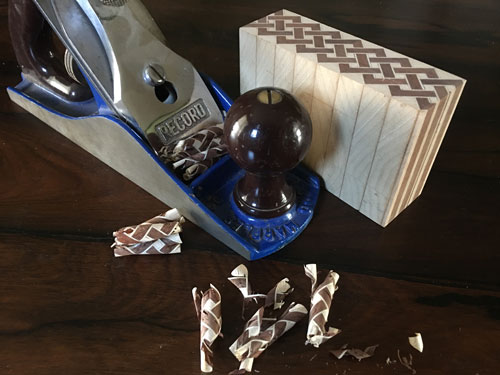
|
Making Yosegi-Zaiku
When I was apprenticing in Los Angeles in 1999, I had hoped to make my own “yosegi zuku” or patterned wood veneers. Traditionally this is done by first by creating a 1 to 3 inch thick pattern seed block from many tiny multi colored pieces of wood, perfectly joined together without gaps. Then it is shaved with a plane. The plane-shavings are ironed flat and saved to be overlaid onto projects. I made my seed block as an image of a braid pattern in two different colors of wood. This was very difficult to make and I was proud to be halfway along in the process. Unfortunately, my braid proved impossible to shave. There were many subtle problems with the block and only recently (2019), have I just begun to understand some of the secrets on how to shave pattens.
My first attempt hand planing a braid pattern I made 20 years ago.
|
Recently, for the very first time, I was able to make a wide “zuku” which requires even greater skill. I hand-planed this pattern from a seed block into sheets using an extra wide Japanese plane called an “o-kanna”.

Using a Japanese O-Kanna (big plane). |

The blade must be perfectly sharp. |

If I pull the plane smoothly it will make a good shaving without gaps. Sometimes I could not do this. |
In Japan these tools are sacred and generally reserved for putting a final finish on temple beams with a single pass. In Hakone, world-famous for its “yosegi”, these planes are sometimes used by the most skilled makers to plane extra wide sheets in one pass. I suspect a new woodworker would have to spend a long time practicing before earning the right to handle the “o-kanna”. I was lucky to meet some very kind people involved with Kezurou-Kai in Oakland who celebrate Japanese tools. In this case, I was very grateful to Jay Van Arsdale to allow me a chance to use his O-Kanna.

I iron the veneer flat. I think there maybe is a more advanced technique to pull a shaving that comes out flat from the plane. |

I am very proud to do this! But there is also more to learn still... |

Finished veneer on top of the Plus Box. |

Since my first seed block cannot be hand-planed into veneers, I opted to saw it instead. Most of material is converted to sawdust. It still makes a beautiful inlay or thick veneer, just many fewer pieces.
home
| about kagen | gallery |
what is new | for sale | tools|
links | kagenbox@gmail.com







